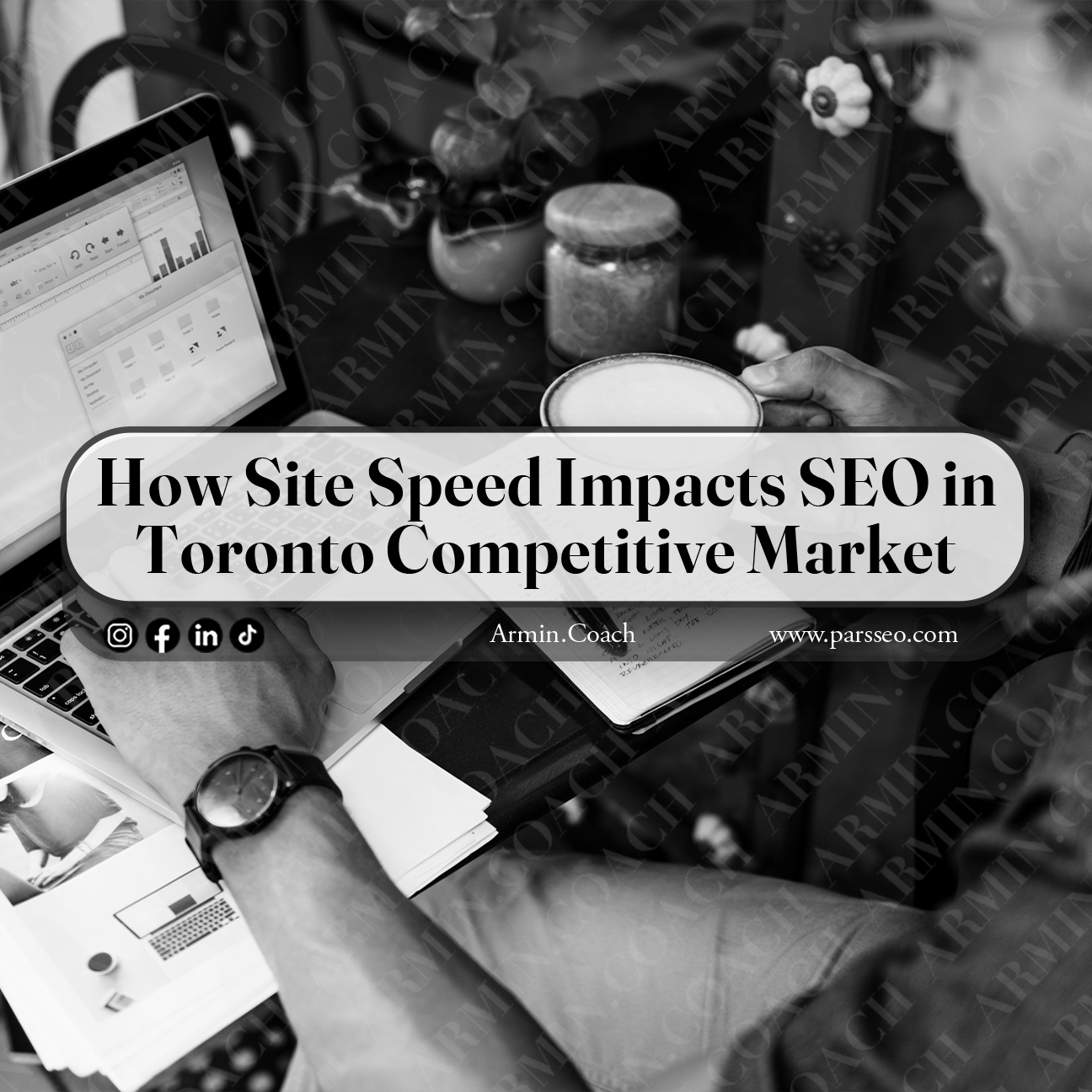Why Site Speed Is the Silent Ranking Factor in Toronto’s SEO Landscape
In the digital ecosystem of 2025, SEO in Toronto has evolved far beyond keyword density and backlinks. Today, site speed—how fast a webpage loads and responds plays a defining role in how Google ranks websites. For businesses operating in Toronto’s hyper-competitive online environment, where users expect seamless digital experiences, even a one-second delay can significantly impact visibility, conversions, and overall brand credibility.
According to Google, 53% of mobile users abandon websites that take more than 3 seconds to load. When applied to a market as crowded and competitive as Toronto’s, that statistic becomes even more critical. Whether you’re a local service provider, eCommerce store, or professional firm, your website’s speed directly influences how users interact with your content—and how search engines interpret your authority and relevance.
This article provides a deep dive into the technical, behavioral, and strategic importance of site speed in achieving strong SEO performance in Toronto. We’ll explore how Google’s Core Web Vitals have redefined optimization, examine case studies of Toronto businesses that improved their rankings through performance enhancement, and provide actionable insights to help your brand rise above local competitors.
The Role of Site Speed in Modern SEO
From Ranking Signal to User Experience Metric
Site speed is no longer just a technical SEO metric it’s a user experience metric. In Google’s ranking algorithm, page load time, interactivity, and visual stability collectively known as Core Web Vitals are key indicators of quality. Websites that meet these metrics consistently outperform slower counterparts in organic search.
Faster sites tend to have:
-
Lower bounce rates
-
Higher dwell time
-
Greater conversion rates
-
Better crawl efficiency
In other words, speed supports both search engine optimization and user satisfaction, creating a dual advantage that directly strengthens your position in Toronto’s SEO ecosystem.
Core Web Vitals and Their Impact
Google’s Core Web Vitals consist of three primary metrics:
-
Largest Contentful Paint (LCP): Measures loading performance. A good LCP score is under 2.5 seconds.
-
First Input Delay (FID): Measures interactivity. A good FID score is under 100 milliseconds.
-
Cumulative Layout Shift (CLS): Measures visual stability. A CLS score under 0.1 is ideal.
In 2024, Google began transitioning FID to Interaction to Next Paint (INP) as a more accurate reflection of responsiveness. For businesses targeting SEO in Toronto, optimizing for these vitals is now essential not optional.
Why Site Speed Matters More in Toronto’s Competitive Market
The Local Market Advantage
Toronto is one of North America’s most digitally mature cities. With thousands of local businesses competing for top search results, the difference between ranking on page one and page two can come down to milliseconds.
Local consumers are tech-savvy and impatient. They expect websites to be as fast and responsive as global brands. Whether they’re booking a salon appointment, comparing accounting firms, or ordering from a local restaurant, the first impression is formed within seconds—and site speed defines that experience.
Mobile-First Indexing and the Toronto User Base
Google’s mobile-first indexing means the mobile version of your website is the primary version for ranking. In Toronto, mobile usage exceeds 75% of all search traffic, making it imperative that your website performs flawlessly on smartphones. A slow-loading mobile site can drastically reduce engagement metrics, leading to poorer SEO results.
Local Competition and Conversion Pressure
In a city where small businesses, startups, and national brands coexist, conversion pressure is intense. Imagine two competing dental clinics in downtown Toronto. Both have optimized content and local citations, but one loads in 1.8 seconds, while the other takes 4.5. The faster site not only ranks higher but also captures more leads due to superior user experience.
The conclusion is clear: in Toronto’s digital economy, speed equals visibility, and visibility drives revenue.
The SEO Science Behind Faster Websites
How Google Measures Speed
Google uses multiple tools and datasets to evaluate site speed, including:
-
Chrome User Experience Report (CrUX): Real-world performance data from Chrome users.
-
PageSpeed Insights: Laboratory and field performance metrics.
-
Lighthouse: Auditing tool for performance, accessibility, and SEO.
-
Core Web Vitals Report (Search Console): Identifies pages that need optimization.
A strong performance score across these platforms enhances SEO in Toronto, as Google rewards websites that provide measurable user satisfaction.
The Crawl Budget and Indexing Efficiency
Fast-loading websites also help search engines crawl and index content more efficiently. When Googlebot encounters a sluggish site, it allocates fewer resources, resulting in slower updates to your search presence. In contrast, a well-optimized site allows for deeper indexing, meaning your new pages, blog posts, and local listings appear faster in search results.
The Connection Between Site Speed and Bounce Rate
Research by Akamai and Google consistently shows that each additional second of page load time increases bounce rates by 32%. For SEO in Toronto—where local intent searches (“near me,” “in Toronto,” “best”) are dominant high bounce rates send negative engagement signals to Google, reducing local rankings over time.
Technical Factors That Influence Site Speed
Server Response Time (TTFB)
Time to First Byte (TTFB) measures how quickly a server responds to a browser’s request. Using local hosting or CDNs with nodes in Toronto can reduce latency and dramatically improve your scores. Businesses targeting Toronto audiences should consider Canadian-based servers for optimal performance.
Image and Media Optimization
High-resolution images are often the largest performance bottlenecks. Compressing images using WebP format, lazy loading below-the-fold assets, and leveraging responsive design ensure your visuals don’t compromise speed.
Code Optimization and Minification
Excessive JavaScript, unoptimized CSS, and unnecessary plugins slow down your pages. Minifying code, deferring non-critical scripts, and removing legacy code improve both speed and SEO in Toronto.
Browser Caching and Content Delivery Networks
Implementing browser caching allows repeat visitors to load your site faster. Meanwhile, Content Delivery Networks (CDNs) like Cloudflare or AWS distribute your content across global servers critical for Toronto businesses serving clients across Canada or internationally.
Mobile Optimization and AMP
Implementing Accelerated Mobile Pages (AMP) and responsive frameworks ensures consistent speed across all devices. Given Toronto’s mobile-centric audience, this step significantly enhances local SEO performance.
Case Studies: Site Speed Success in Toronto SEO
Example 1: Local E-commerce Store
A Toronto-based boutique fashion retailer saw a 38% increase in organic traffic and 22% higher conversions after optimizing image compression and server response time. Their average page load speed decreased from 4.1 to 1.9 seconds, improving their rankings for “women’s fashion Toronto.”
Example 2: Professional Services Firm
A mid-sized law firm in North York implemented Core Web Vitals improvements and reduced JavaScript execution time. Within two months, they observed:
-
+19% increase in search impressions
-
+26% boost in lead generation
-
Bounce rate reduction from 62% to 37%
This illustrates how speed and trust signals translate directly into better SEO outcomes in Toronto.
Example 3: Local Restaurant Chain
A restaurant franchise optimized its mobile pages and CDN setup. As a result, its Google Business Profile visibility improved by 31%, and local SEO traffic surged due to faster location pages.
Measuring and Monitoring Site Speed
Key Tools for Toronto SEO Agencies
-
Google PageSpeed Insights: for real-time lab and field data.
-
GTmetrix (Toronto server): measures local loading performance.
-
Lighthouse: for auditing and continuous improvement.
-
WebPageTest.org: advanced filmstrip analysis.
-
Google Analytics 4 (GA4): to track behavioral metrics like bounce and engagement rate.
Benchmarking Against Competitors
SEO in Toronto is data-driven. By benchmarking your site’s performance against local competitors using tools like Ahrefs, Semrush, and GTmetrix, you can identify performance gaps that directly impact rankings.
Ongoing Monitoring
Site speed optimization is not a one-time fix. Continuous monitoring ensures your site remains compliant with evolving algorithms and user expectations. Toronto agencies often employ monthly performance audits as part of their SEO maintenance services.
The Business Impact of Faster Websites
Conversion Rate Optimization
A Google study revealed that improving site speed by just 0.1 seconds can increase conversions by up to 8%. For Toronto e-commerce businesses with thousands of monthly visitors, this small adjustment can yield substantial revenue growth.
Brand Perception and Trust
Fast websites communicate professionalism and reliability qualities Toronto consumers value. Conversely, a slow website can subconsciously signal inefficiency or lack of credibility.
SEO ROI Enhancement
Investing in site speed optimization yields measurable ROI through:
-
Higher search rankings
-
Lower ad spend (via improved Quality Score)
-
Better organic conversion performance
These outcomes collectively strengthen your overall SEO in Toronto strategy.
The Cost of Neglecting Site Speed
Lost Rankings and Visibility
Sluggish websites fall behind in competitive SERPs. Even if your content is exceptional, poor performance will limit your organic reach especially in Toronto’s dense search market.
Reduced Crawl Efficiency
Slow pages consume more of Googlebot’s crawl budget, reducing how often and how deeply your site is indexed.
Negative User Sentiment
Visitors rarely return to a slow website. In a city with abundant options, this directly impacts brand loyalty and local SEO authority.
How to Improve Site Speed for Better SEO in Toronto
Step 1: Audit and Analyze
Start by running audits using PageSpeed Insights and GTmetrix (Toronto server location). Identify major bottlenecks such as render-blocking scripts or unoptimized assets.
Step 2: Optimize Hosting and Infrastructure
Choose a hosting provider with data centers in Canada or CDN coverage in Ontario. This ensures lower latency and improved TTFB.
Step 3: Implement Lazy Loading and Image Compression
Use modern image formats like WebP and apply lazy loading to defer below-the-fold assets. This technique alone can cut load times by up to 40%.
Step 4: Reduce Third-Party Scripts
Limit heavy analytics, chat widgets, and social feeds that add unnecessary load.
Step 5: Minify, Combine, and Cache
Minify HTML, CSS, and JavaScript files, and implement long-term caching headers to enhance repeat visit speed.
Step 6: Monitor and Iterate
SEO in Toronto requires continuous improvement. Use GA4 and Search Console to track performance and adjust strategies monthly.
Comparing the Costs and Benefits of Speed Optimization
| Factor | Cost (Approx.) | Benefit |
|---|---|---|
| Image compression & minification | $300–$700 | Faster load, better UX |
| CDN integration | $50–$200/month | Global content delivery |
| Hosting upgrade | $50–$150/month | Reduced TTFB |
| Core Web Vitals optimization | $1,000–$3,000 (one-time) | Higher SEO rankings |
| Continuous monitoring | $200/month | Sustained performance |
ROI Insight: Most Toronto businesses see a return on investment within 3–6 months of implementing comprehensive site speed improvements.
(FAQs)
Q1: How much does site speed affect SEO in Toronto?
A great deal. It’s both a ranking factor and a conversion driver. Faster websites have better Core Web Vitals scores, leading to stronger organic visibility.
Q2: What is a good page speed score for Toronto-based websites?
Aim for a PageSpeed Insights score of 90+ and load times under 2.5 seconds for both desktop and mobile.
Q3: Does local hosting improve SEO in Toronto?
Yes. Hosting on Canadian servers or using a CDN with Toronto nodes reduces latency, improving Core Web Vitals and local ranking performance.
Q4: How often should I audit my website’s speed?
Quarterly audits are ideal, though high-traffic e-commerce sites should run monthly speed assessments.
Q5: Can site speed improvements boost Google Ads performance too?
Absolutely. Faster landing pages lead to higher Quality Scores, lower CPCs, and better ad placement.
Conclusion
In the competitive digital market of Toronto, where every business is striving for top visibility, site speed has emerged as the ultimate differentiator. It influences how search engines perceive your authority, how users experience your brand, and how effectively you convert visitors into clients.
By optimizing for Core Web Vitals, leveraging CDNs, and maintaining continuous performance monitoring, Toronto-based businesses can secure a decisive edge. Faster websites don’t just rank better they build trust, enhance engagement, and drive sustainable growth.





